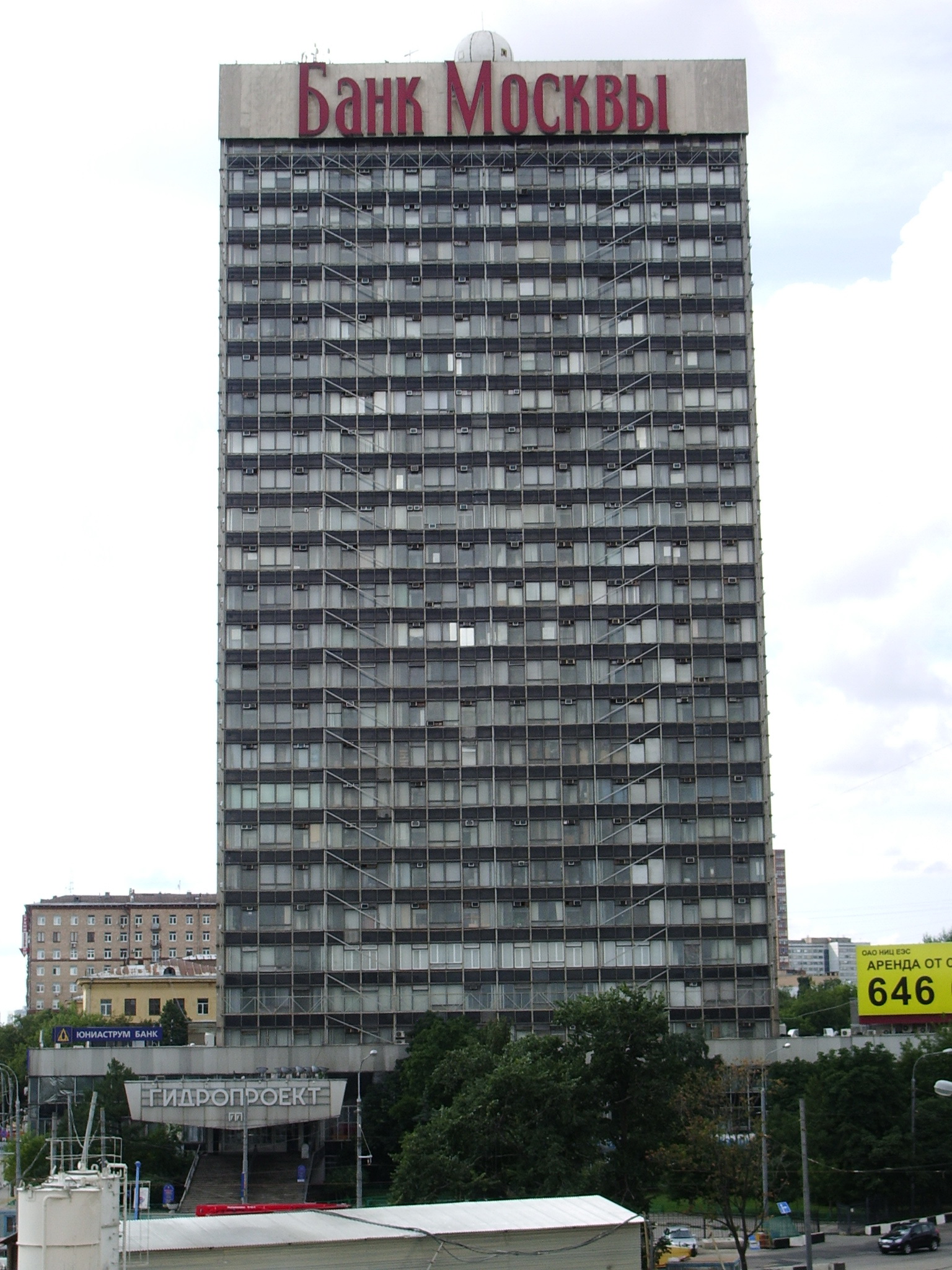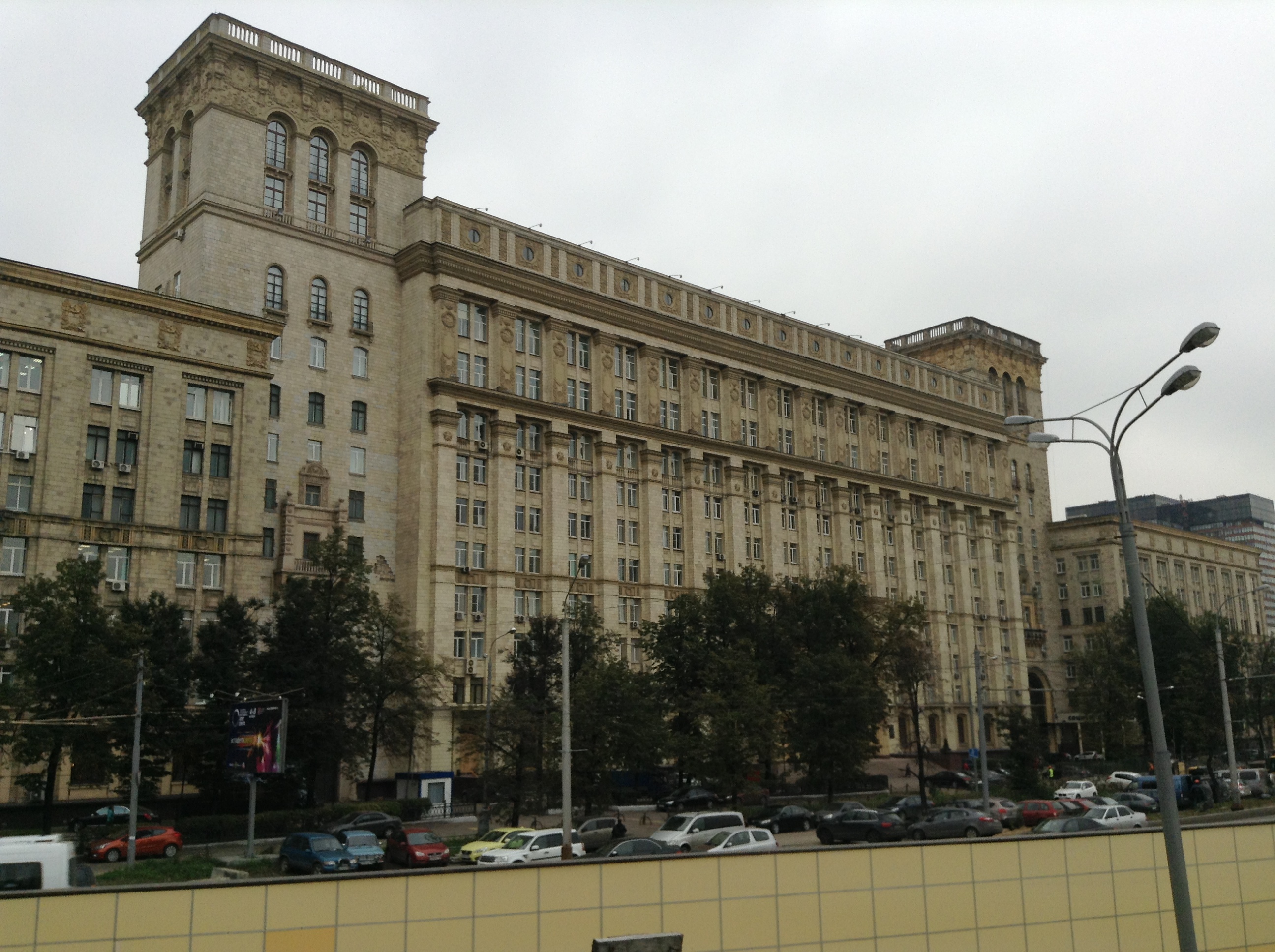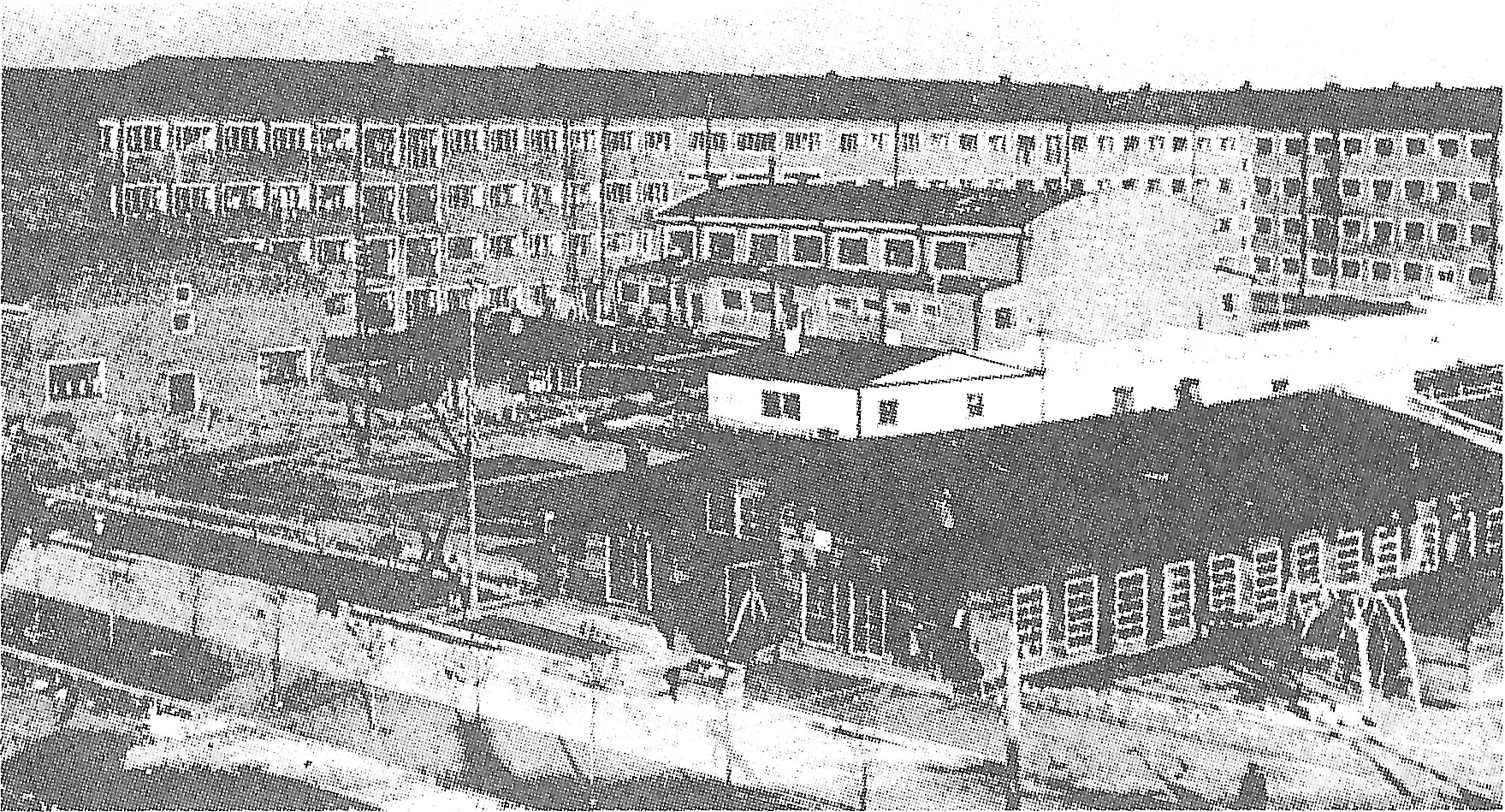|
Sokol District
Sokol District (russian: райо́н Со́кол) is an administrative district (raion), one of the sixteen in Northern Administrative Okrug of the federal city of Moscow, Russia.Law #13-47 The area of the district is As of the 2010 Census, the total population of the district was 57,133. History The district is named after the settlement of Sokol built in the 1920s. Earlier, the village of Vsekhsvyatskoye existed at the same location. During the Red Terror, mass executions of suspected counterrevolutionaries and various political opponents were conducted here at a local cemetery, which is now a memorial complex. In 1938, Sokol metro station opened here. Sokol in Current Moscow Sokol is a very family-oriented place to live. It has 3 parks, multiple top-tier schools and after school activities such as volleyball and music school within walking distance. it is centrally located and is only a 20 minute drive from the center. Sokol also has the very first Moscow music sc ... [...More Info...] [...Related Items...] OR: [Wikipedia] [Google] [Baidu] |
Leningradskoye Highway
Leningradskoye Highway (russian: Ленинградское шоссе) is a part of M10 federal highway Moscow – Saint Petersburg inside Moscow. One of the major thruways of Russia's capital, it connects Moscow with several large commuter towns such as Khimki and Zelenograd, as well as with Sheremetyevo Airport. Route Leningradskoye Highway begins in Sokol District in Northern Administrative Okrug where it derives from Leningradsky Prospekt along with Volokolamskoye Highway. The highway follows northwestbound, crosses Rizshkaya Railway and goes along the border between Voykovsky District and Koptevo District. After crossing Small railway ring Leningradskoye Highway enters Golovinsky District. There is an interchange with Golovinskoye Highway near Vodny Stadion metro station. Until 2008 this crossing was served by traffic lights. That was the last traffic light on the highway. After crossing Flotskaya Street the highway follows across Levobereznhy District. There ... [...More Info...] [...Related Items...] OR: [Wikipedia] [Google] [Baidu] |
Moscow Metro
The Moscow Metro) is a metro system serving the Russian capital of Moscow as well as the neighbouring cities of Krasnogorsk, Reutov, Lyubertsy and Kotelniki in Moscow Oblast. Opened in 1935 with one line and 13 stations, it was the first underground railway system in the Soviet Union. , the Moscow Metro, excluding the Moscow Central Circle, the Moscow Central Diameters and the Moscow Monorail, has 250 stations (287 with Moscow Central Circle) and its route length is , making it the fifth-longest in the world and the longest outside China. The system is mostly underground, with the deepest section underground at the Park Pobedy station, one of the world's deepest underground stations. It is the busiest metro system in Europe, and is considered a tourist attraction in itself. Operations The Moscow Metro, a state-owned enterprise, is long and consists of 15 lines and 250 stations organized in a spoke-hub distribution paradigm, with the majority of rail lines running rad ... [...More Info...] [...Related Items...] OR: [Wikipedia] [Google] [Baidu] |
World War I
World War I (28 July 1914 11 November 1918), often abbreviated as WWI, was List of wars and anthropogenic disasters by death toll, one of the deadliest global conflicts in history. Belligerents included much of Europe, the Russian Empire, the United States, and the Ottoman Empire, with fighting occurring throughout Europe, the Middle East, Africa, the Pacific Ocean, Pacific, and parts of Asia. An estimated 9 million soldiers were killed in combat, plus another 23 million wounded, while 5 million civilians died as a result of military action, hunger, and disease. Millions more died in Genocides in history (World War I through World War II), genocides within the Ottoman Empire and in the Spanish flu, 1918 influenza pandemic, which was exacerbated by the movement of combatants during the war. Prior to 1914, the European great powers were divided between the Triple Entente (comprising French Third Republic, France, Russia, and British Empire, Britain) and the Triple A ... [...More Info...] [...Related Items...] OR: [Wikipedia] [Google] [Baidu] |
Sokol All Saints Church 03-2011 01
The Sokol movement (, ''falcon'') is an all-age gymnastics organization first founded in Prague in the Czech region of Austria-Hungary in 1862 by Miroslav Tyrš and Jindřich Fügner. It was based upon the principle of " a strong mind in a sound body". The Sokol, through lectures, discussions, and group outings provided what Tyrš viewed as physical, moral, and intellectual training for the nation. This training extended to men of all ages and classes, and eventually to women. The movement also spread across all the regions populated by Slavic cultures, most of them part of either Austria-Hungary or the Russian Empire: present-day Slovakia, the Slovene Lands, Croatia, Serbia ( SK Soko), Bulgaria, Poland ( Sokół), Ukraine, Belarus. In many of these nations, the organization also served as an early precursor to the Scouting movements. Though officially an institution "above politics", the Sokol played an important part in the development of Czech nationalism and patriotism ... [...More Info...] [...Related Items...] OR: [Wikipedia] [Google] [Baidu] |
Hydroproject
Hydroproject (russian: Институт «Гидропроект», Gidroproekt) is a Russian hydrotechnical design firm. Based in Moscow, it has a number of branches around the country. Its main activities are design of dams, hydroelectric stations, canals, sluices, etc. Hydroproject and its predecessor institutions have designed most of the hydroelectric dams and irrigation and navigation canals that have been built in the Soviet Union and Russia since the 1930s. They have designed a number of high-profile projects abroad as well, from India to Egypt to Canada. The institute, under Sergey Yakolevich Zhuk's leadership, also researched the Northern river reversal's potential. Furthermore, it has been involved in realising nuclear power plants in the Soviet Union between 1969 and 1986. History Hydroproject traces its history to the design departments of the Moscow Canal Construction Project (the 1930s), and the Hydroelectrostroy Trust (Трест “Гидроэлектрос ... [...More Info...] [...Related Items...] OR: [Wikipedia] [Google] [Baidu] |
GSKB Almaz-Antey
JSC NPO Almaz named after A.A. Raspletin (russian: link=no, ГСКБ Концерна ПВО "Алмаз-Антей", former SB-1, 1947–50; KB-1, 1950–66; MKB Strela, 1966–71; TsKB Almaz, 1971–88; NPO Almaz, 1988–2008; GSKB Almaz-Antey, 2008–15) is a Soviet/Russian military R&D enterprise founded in 1947. It is the core of the Almaz-Antey holding. Headquarters – Moscow, Leningradsky av., 80. History The company is named after its chief designer . Since 1955, KB-1 developed such air defence missile systems as the S-25 Berkut, S-75 Dvina, S-125 Neva/Pechora, S-200 Angara/Vega/Dubna, S-300, S-400 Triumf, S-300PMU, S-300PMU2, and S-350E Vityaz. On 30 November 2009, the board of directors of Almaz-Antey voted to reorganize the joint-stock companies NIEMI, NIIRP, MNIIRE Altair and MNIIPA, merging them with NPO Almaz to form GSKB joint venture. GSKB became the head R&D arm of Almaz-Antey holdings, becoming its Head System Design Bureau (russian: link=no, ГСКБ ... [...More Info...] [...Related Items...] OR: [Wikipedia] [Google] [Baidu] |
Moscow University Of Industry And Finance
Moscow ( , US chiefly ; rus, links=no, Москва, r=Moskva, p=mɐskˈva, a=Москва.ogg) is the capital and largest city of Russia. The city stands on the Moskva River in Central Russia, with a population estimated at 13.0 million residents within the city limits, over 17 million residents in the urban area, and over 21.5 million residents in the metropolitan area. The city covers an area of , while the urban area covers , and the metropolitan area covers over . Moscow is among the world's largest cities; being the most populous city entirely in Europe, the largest urban and metropolitan area in Europe, and the largest city by land area on the European continent. First documented in 1147, Moscow grew to become a prosperous and powerful city that served as the capital of the Grand Duchy that bears its name. When the Grand Duchy of Moscow evolved into the Tsardom of Russia, Moscow remained the political and economic center for most of the Tsardom's history. When the ... [...More Info...] [...Related Items...] OR: [Wikipedia] [Google] [Baidu] |
Stroganov Moscow State University Of Arts And Industry
Moscow State Stroganov Academy of Industrial and Applied Arts (russian: Московская Государственная Художественно-Промышленная Академия им. С.Г. Строганова) informally named Stroganovka (Строгановка) is one of the oldest Russian schools for the industrial, monumental and decorative art and design. The University is named after its founder, baron Sergei Grigoriyevich Stroganov. History The school was founded in 1825 by Baron Sergey Stroganov. It specialised on the applied and decorative art. In 1843 the school became state-owned. In 1860 it was renamed Stroganov School for Technical Drawing. First Free State Art Workshops After the October Revolution the school was reorganized and became one of the SVOMAS, known as the First Free State Art Workshops. Later changes Since 1930 it became the Moscow Institute for the Decorative and Applied Arts (Московский Институт Декоратив� ... [...More Info...] [...Related Items...] OR: [Wikipedia] [Google] [Baidu] |
Moscow Aviation Institute
Moscow Aviation Institute (National Research University) (MAI; russian: Московский авиационный институт, МАИ) is one of the major engineering institutes in Moscow, Russia. Since its inception MAI has been spearheading advances in aerospace technology both within Russia and worldwide. The university laid emphasis on laboratory instruction in applied science and engineering, specific to the demands of aerospace industry. During World War II part of the university was evacuated to Almaty, Kazakhstan. Staffs and students continued to work on research and wartime production throughout the war. During the Post-War period, the university expanded and assimilated new technologies during the Jet age. Research conducted in the university contributed to heralding the space age. The university has to its merit more than 160,000 specialists, 250 chief designers in the Aerospace Industry. 50 Academicians of the Russian Academy of Sciences, 22 cosmonauts ... [...More Info...] [...Related Items...] OR: [Wikipedia] [Google] [Baidu] |
Subdivisions Of Russia
Russia is divided into several types and levels of subdivisions. Federal subjects Since 30 September 2022, the Russian Federation has consisted of eighty-nine federal subjects that are constituent members of the Federation.Constitution, Article 65 However, six of these federal subjects—the Republic of Crimea, the Donetsk People's Republic, the Kherson Oblast, the Lugansk People's Republic, the federal city of Sevastopol and the Zaporozhye Oblast—are internationally recognized as part of Ukraine. All federal subjects are of equal federal rights in the sense that they have equal representation—two delegates each—in the Federation Council (upper house of the Federal Assembly). They do, however, differ in the degree of autonomy they enjoy. De jure, there are 6 types of federal subjects—24 republics, 9 krais, 48 oblasts, 3 federal cities, 1 autonomous oblast, and 4 autonomous okrugs. Autonomous okrugs are the only ones ... [...More Info...] [...Related Items...] OR: [Wikipedia] [Google] [Baidu] |
Sokol (Moscow Metro)
Sokol (russian: Со́кол, en, Falcon) is a Moscow Metro station on the Zamoskvoretskaya Line. The station opened on 11 September 1938. Designed by K. Yakovlev, V. Polikarpova, and V. Andreev, it features a single row of pillars which flare upward into the arched ceiling, separated by circular coffers. Sokol is finished in a variety of materials, including white and gray Koyelga marble, onyx, granite, and white ceramic tile. The two entrances to the station are located on both sides of Leningradsky Prospekt. An additional exit to the underpass is available from the south end of the platform. Another entrance was cut in 2003 from the nearby Metro Market shopping center. It was the northwestern terminus of the line until 1964 when 3 northern stations were opened. A Zamoskvoretskaya Line The Zamoskvoretskaya line (russian: link=no, Замоскворе́цкая ли́ния, ), formerly Gorkovsko–Zamoskvoretskaya () (Line 2), is a line of the Moscow Metro. Opened in 1938, c ... [...More Info...] [...Related Items...] OR: [Wikipedia] [Google] [Baidu] |





